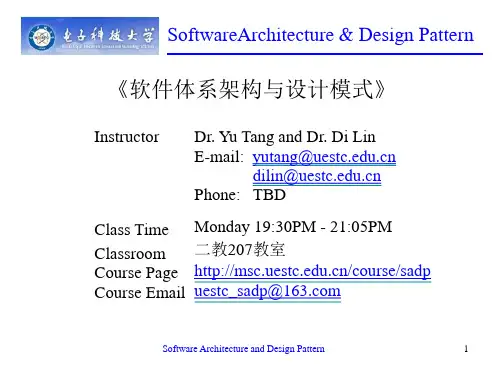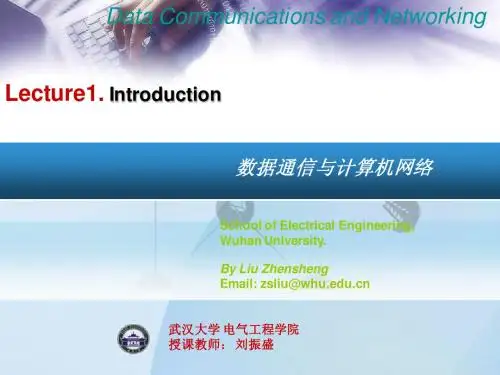Lecture_1_-_Introduction_and_Course_Overview.ppt.Convertor
- 格式:doc
- 大小:21.58 KB
- 文档页数:21






Corporate FinanceInstructor: Tang ZongmingDepartment :FinanceOffice phone:52301359Email address: zmtang@Fall, 20101MotivationWhy study corporate finance?2Lecture 1 IntroductionWhat is corporate finance and the role of financial manager?Corporate governanceThe Goal of Financial ManagementThe Agency Problem and Control of the CorporationNPV approach in corporate financePoints review: five financial principles33www: This is a good place to show the students the web site that accompanies the book, including the various features that they can access for study purposes (study guide, quizzes, web links, etc.). Click on the “web surfer” icon to go directly to the site.Some background knowledge of FinanceTheory:Investment(1952 - )Corporate Finance(1956 - )Asset Pricing(1962 - ,1973 -,1985 -)Applications:Fund(1970 -)Future and Option(1970 - )Fixed Income Markets and Their Derivatives (1970 -)Corporate Governance Structure(1980 -)Securitization of Housing Mortgage Loans (1980 -)Financial Engineering (1980 -)Risk Management(1990 -)VC & PE(1990 -)Hedge Fund(1990 -)Credit Loan Securitization (1990 -)Asset securitization, Risk Marketization, Conglomerated Financial Operations, financial information service Market(1990 -)4Some high points of the historyMarkowits and the theory of portfolio selection(1950s)The Modigliani-Miller Propositions(1950s)William Sharp and CAPM(1960s)The Efficient Markets Hypothesis(1960s)Option pricing theory(1970s)Agency theory(1980s)From1950s5The Revolution in Corporate FinanceBeginning with the work of Merton Miller and Francisco Modigliani in the late 1950sA basic change in the theory of valuation“Accounting model” to“Economic model”Approaches : general equilibrium analysis and utility analysis6Corporate FinanceSub discipline of economics–The theory of the firmRequires an understanding ofThe banking systemCapital marketsThe operation of money7What is Corporate FinanceObjectiveMaximizing shareholders’ wealthStrategymanagement of ASSETS , financing and acquisition (8)Operational ConsiderationsAsset ManagementHow do you achieve the most efficient asset mix? Cash flow considerations9Operational ConsiderationsAsset FinancingWhat is the best type of financing?What is the best financing mix?10Operational ConsiderationsAsset AcquisitionWhich are the best assets to buy?When should you buy them?11What is Corporate Finance in our textbookIt is about how to allocate the corporate resources,What long-term investments should the firm take on?Where will we get the long-term financing to pay for the investment?How will we manage the everyday financial activities of the firm?How to realize value creation through firm extension?1212Emphasize that “business finance” is just another name for the “corporate finance” mentioned under the four basic types. Students often get confused by the terminology, especially when different terms are used to refer to the same thing.Who cares corporate financeInvestor (dividends,capital gains)Bank (debt financing)Firm’s owner (value of firm)Government (tax)13Financial ManagerFinancial managers try to answer some or all of these questionsThe top financial manager within a firm is usually the Chief Financial Officer (CFO)Treasurer –oversees cash management, credit management, capital expenditures and financial planningController – oversees taxes, cost accounting, financial accounting and data processing1414Video Note: This video looks at the changing role of the Chief Financial Officer (CFO) at the Fortune 500 company, Abbot Laboratories.Finance in theOrganizational Structure of the FirmBoard of DirectorsPresidentTreasurerControllerCreditManagerInventoryManagerDirector ofCapitalBudgetingCostAccountingFinancialAccountingTaxDepartmentVice-President: FinanceVice-President: SalesVice-President: Manufacturing15Role of The Financial ManagerFinancialmanagerFirm'soperationsFinancialmarkets16Three main kinds of Financial Management Decisions1.Capital budgetingWhat long-term investments or projects should the business take on?Capital budgeting –process of planning and managing a firm’s investments in fixed assets The key concerns are the size, timing and riskiness of future cash flows.1717Provide some examples of capital budgeting decisions, such as what product or service will the firm sell, should we replace old equipment with newer, more advanced equipment, etc.Be sure and define debt and equity.Provide some examples of working capital management, such as who should we sell to on credit, how much inventory should we carry, when should we pay our suppliers, etc.Three main kinds of Financial Management Decisions2.Capital structureHow should we pay for our assets?Should we use debt or equity?Capital structure – mix of debt (borrowing) and equity (ownership interest) used by a firm.What are the least expensive sources of funds?Is there an optimal mix of debt and equity? When and where should the firm raise funds?1818Provide some examples of capital budgeting decisions, such as what product or service will the firm sell, should we replace old equipment with newer, more advanced equipment, etc.Be sure and define debt and equity.Provide some examples of working capital management, such as who should we sell to on credit, how much inventory should we carry, when should we pay our suppliers, etc.Three main kinds of Financial Management Decisions3.Working capital managementHow do we manage the day-to-day finances of the firm?Working capital management – managing short-term assets and liabilities.How much inventory should the firm carry?What credit policy is best?Where will we get our short-term loans?1919Provide some examples of capital budgeting decisions, such as what product or service will the firm sell, should we replace old equipment with newer, more advanced equipment, etc.Be sure and define debt and equity.Provide some examples of working capital management, such as who should we sell to on credit, how much inventory should we carry, when should we pay our suppliers, etc.202. Corporate governance:What Is A Corporation?Sole ProprietorshipsCorporationsPartnerships212. Corporate governanceThe goal of the firmMaximize the wealth of shareholdersSeparation of ownership and managementAgent and principalConflicts of interest between agent and principalCorporate governance: a mechanism to solve the conflicts of interest between agents and principals 22Corporate governance Structure of the FirmBoard of DirectorsPresidentVice-President: FinanceVice-President: SalesVice-President: ManufacturingShareholder committeeBoard of supervisors23The Agency ProblemAgency relationshipPrincipal hires an agent to represent his/her interestStockholders (principals) hire managers (agents) to run the companyAgency problem (agency costs)Conflict of interest between principal and agentagency costs2424A common example of an agency relationship is a real estate broker –in particular if you break it down between a buyers agent and a sellers agent. A classic conflict of interest is when the agent is paid on commission, so they may be less willing to let the buyer know that a lower price might be accepted or they may elect to only show the buyer homes that are listed at the high end of the buyers price range.Ethics Note: The instructor’s manual provides a discussion of Gillette and the apparent agency problems that existed prior to the introduction of the sensor razor.Direct agency costs –the purchase of something for management that can’t be justified from a risk-return standpoint, monitoring costs.Indirect agency costs –management’s tendency to fo rgo risky or expensive projects that could be justified from a risk-return standpoint.The types of agency costDirect costs – compensation and perquisites for managementAudit /monitoringPurchase of luxurious and unneeded thingsIndirect costs – cost of monitoring and sub optimal decisionsEx. Investment opportunity25Managing ManagersManagerial compensationIncentives can be used to align management and stockholder interests ( Stock option & Harvard studies)The incentives need to be structured carefully to make sure that they achieve their goal(e.g.EVA)(stern stewart& company)Corporate controlThe threat of a takeover may result in better management (why?)2626Incentives –discuss how incentives must be carefully structured. For example, tying bonuses to profits might encourage management to pursue short-run profits and forego projects that require a large initial outlay. Stock options may work, but there may be an optimal level of insider ownership. Beyond that level, management may be in too much control and may not act in the best interest of all stockholders. The type of stock can also affect the effectiveness of the incentive.Corporate control – ask the students why the threat of a takeover might make managers work towards the goals of stockholders.Other groups also have a financial stake in the firm. They can provide a valuable monitoring tool, but they can also try to force the firm to do things that are not in the owners’ best interest.Agency Problem Solutions1 - Compensation plans2 - Board of Directors3 - Takeovers4 - Specialist Monitoring5 - Auditors27183.NPV ApproachWealth MaximizationCash flowsTimingRisk versus ReturnGoal = steadily appreciating share price28Wealth MaximizationProfit- useful but ignoresRiskTime value of money29Wealth MaximizationCash Flow – belong to all investorsNet Present Value (NPV)The present value of all future cash flows minus initial cost 30Present and Future ValuePresent ValueValue today of a future cash flow.Future ValueAmount to which an investment will grow after earning interest31Discount Factors and RatesDiscount RateInterest rate used to compute present values of future cash flows.Discount FactorPresent value of a $1 future payment.32Present Value33Present ValueDiscount Factor = DF = PV of $1Discount Factors can be used to compute the present value of any cash flow.34Valuing an Office BuildingStep 1: Forecast cash flowsCost of building = C0 = 400,000Sale price in Year 1 = C1 = 420,000Step 2: Estimate opportunity cost of capitalIf equally risky investments in the capital marketoffer a return of 5%, thenCost of capital = r = 5%35Valuing an Office BuildingStep 3: Discount future cash flowsStep 4: Go ahead if PV of payoff exceeds investment36Net Present Value37Risk and Present ValueHigher risk projects require a higher rate of return Higher required rates of return cause lower PVs38Risk and Present Value39Risk and Net Present Value40Rate of Return RuleAccept investments that offer rates of return in excess of their opportunity cost of capitalExampleIn the project listed below, the foregone investment opportunity is 12%. Should we do the project?41Net Present Value RuleAccept investments that have positive net present valueExampleSuppose we can invest $50 today and receive $60 in one year. Should we accept the project given a 10% expected return?42Opportunity Cost of CapitalExampleYou may invest $100,000 today. Depending on the state of the economy, you may get one of three possible cash payoffs:43Opportunity Cost of CapitalExample - continuedThe stock is trading for $95.65. Next year’s price, given a normal economy, is forecast at $110The stocks expected payoff leads to an expected return.44Opportunity Cost of CapitalExample - continuedDiscounting the expected payoff at the expected return leads to the PV of the projectNPV requires the subtraction of the initial investment45Opportunity Cost of CapitalExample - continuedNotice that you come to the same conclusion if you compare the expected project return with the cost of capital.46What Is a Firm Worth?Conceptually, a firm should be worth the present value of the fir m’s cash flows.The tricky part is determining the size, timing and risk of those cash flows.NPV of buying a firm=Firm worth –Firm price474. Five Foundational Principles of FinanceCash flow is what mattersMoney has a time valueRisk requires a rewardMarket prices are generally rightConflicts of interest cause agency problems48Five Principles“…while it is not necessary to understand finance in order to understand these principles, it is necessary to understand these principles in order to understan d finance.”49Principle 1:Cash flow is what mattersAccounting profits are not equal to cash flows. It is possible for a firm to generate accounting profits but not have cash or to generate cash flows but not report accounting profits in the books.Cash flow, and not profits, drive the value of a business.We must determine incremental cash flows when making financial decisions.Incremental cash flow is the difference between the projected cash flows if the project is selected, versus what they will be, if the project is not selected.50Success but no profitCase of Movie industry in USSome of the most successful box office hits-Forrest Gump, Coming to America, and Batman---realized no accounting profits at all after accounting for various movie st udio costs.This is because “Hollywood Accounting” allows for overhead costs not related to the movie to be added to the true cost of the movie.51Movie: My Big Fat Greek WeddingLost $20 millionIn fact, it grossed over $370 million on a budget of $5 million52Principle 2:Money has a time valueA dollar received today is worth more than a dollar received in the future.Since we can earn interest on money received today, it is better to receive money earlier rather than later.53Principle 3:Risk requires a RewardWe won’t take on additional risk unless we expect to be compensated with additional reward or return. Investors expect to be compensated for “delaying consumption” and “taking on risk”.Thus investors expect a return when they put their savings in a bank (i.e. delay consumption) and they expect to earn a higher rate of return on stocks relative to bank savings account (i.e. taking on risk)54Figure 1-155Principle 4: Market Pricesare generally RightIn an efficient market, the prices of all traded assets (such as stocks and bonds) at any instant in time fully reflect all available information.Thus stock prices are a useful indicator of the value of the firm. Prices changes reflect changes in expected future cash flows. Good decisions will tend to increase the stock prices and vice versa. Note there are inefficiencies in the market that may distort the prices.56Principle 5: Conflicts of interest cause agency problemsThe separation of management and the ownership of the firm creates an agency problem. Managers may make decisions that are not consistent with the goal of maximizing shareholder wealth.Agency conflict is reduced through monitoring(ex. Annual reports), compensation schemes(ex. stock options), and market mechanisms(ex. Takeovers)57Course outlinePart 1 Foundations of Finance1-Introduction2-Free cash flowPart 2 Capital Budgeting3- Investment Decision (1)4- Investment Decision(2)5- Investment Decision(2)Part 3 Risk and Return6-Risk and CAPM7-Arbitrage pricing theory8-Capital budgeting and riskPart 4 Financing and Capital Structure 10-Financing Decisions11-Capital structure12-captial budg.forlev. Firm13-dividend policyPart 5 valuation14-Security valuation15-Firm valuation-16-M&A17-review58SummaryWhat is Corporate Finance? Corporate governanceNPV approachCourse overviewFive financial principles59The end of lecture 160。